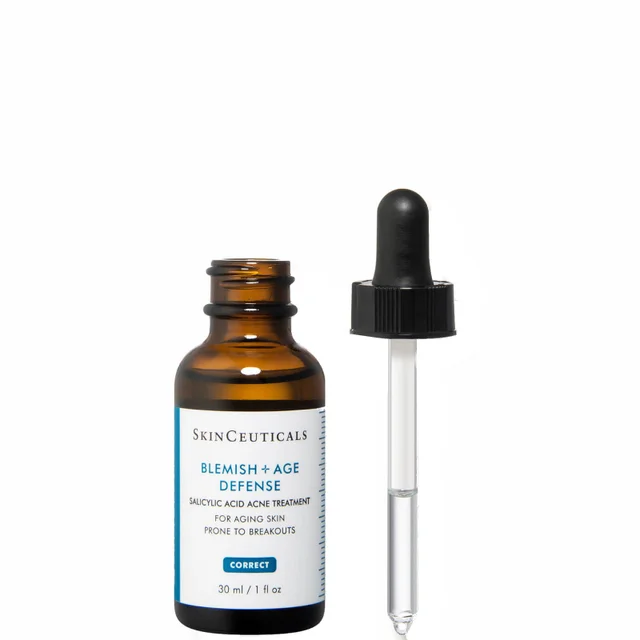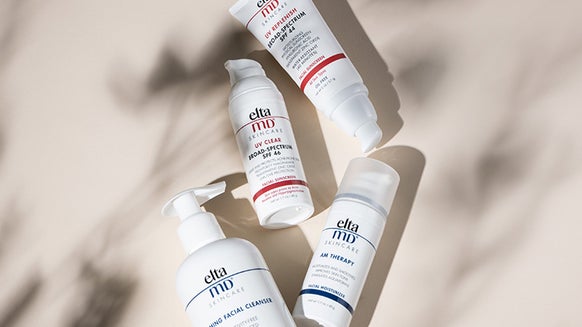Hydroxy Acids: What They Do and Which Ones Are Right for You
At this stage, most of us have used a product or two that contains hydroxy acids. Glycolic, lactic, salicylic—we’ve heard of them. We know they work, but what exactly does each of them do? How are they different from one another? And, most important, which ones do what best? Let us break it down for you.
How Hydroxy Acids Work
Hydroxy acids “smooth, tighten, firm and brighten,” says Stanley Jacobs, M.D., a triple-board certified facial plastic surgeon in San Francisco. And while higher concentrations of these acids are used in professional treatments, “almost everyone can tolerate them in lower concentrations and over-the-counter formulations, and will notice significant improvements in their skin when used as directed,” Dr. Jacobs says.
But how exactly do these multitaskers-in-a-bottle work? “Hydroxy acids weaken the ‘cellular glue’ that makes dead skin cells stick together, encouraging exfoliation and revealing healthy, younger skin cells,” explains Haleh Bakshandeh, M.D., a board-certified dermatologist based in Beverly Hills. “Hydroxy acids at medium-to-higher concentrations can also function beyond the surface of the skin and work in the epidermal and dermal layers to deliver additional results, such as collagen and elastin remodeling, pigment lightening and melanin suppression (i.e., keeping brown spots at bay).”
The Hydroxy Acid Alphabet
Hydroxy acids fit into three categories:
Though there are various types of acids, glycolic, lactic, mandelic and salicylic acids have the most clinical research behind them and the most studies supporting their efficacy. That’s why they’re also the most commonly used acids in skin care products. Here’s what else you need to know about each of them:
Alpha Hydroxy Acids
- GLYCOLIC ACID
In a nutshell: This naturally occurring sugarcane-derived AHA has long been considered by many professionals to be the best performing acid. As the smallest hydroxyl acid molecule,
Why it works: Like all AHAs, glycolic acid exfoliates the skin by dissolving the cellular glue and exfoliating superficial, dead skin cells. Because glycolic penetrates the deepest—and some studies suggest all the way into the dermis—it has been shown to be the most effective at stimulating collagen production, thus better promoting deeper wrinkle reduction.
Who will benefit from it: Aside from reducing wrinkles, glycolic acid is also effective at reducing photodamage, which makes it ideal for those with more mature skin. If you have dry skin, you’ll also find glycolic particularly useful, because it draws moisture to the skin and helps prevent transepidermal water loss. It also increases the hyaluronic acid levels in the skin.
What else you need to know: It’s important to know that because glycolic acid penetrates quickly, it can be more irritating than other AHAs and is sometimes not tolerated well by sensitive skin types.
- LACTIC ACID
In a nutshell:
Why it works: Like glycolic acid, lactic acid exfoliates as it increases moisture levels in the top layers of the skin, improving barrier function and resistance to dryness and flakiness.
Who will benefit from it: Like all AHAs, lactic acid is great for general exfoliation and skin brightening. But because this is a larger molecule, lactic acid does not penetrate as deeply into skin’s surface as glycolic acid, making it somewhat gentler. Dr. Bakshandeh explains: “Those with sensitive skin often prefer lactic products over glycolic acid products because they tend to see less inflammation in the skin after use, but get similar desired results.”
What else you need to know: Studies show that low concentrations and medium (12%) concentrations of lactic acid can increase epidermal and dermal firmness and thickness of skin as well as reduce the appearance of lines and wrinkles. It can also clear sunspots by accelerating cell turnover and directly inhibiting melanin production.
- MANDELIC ACID
In a nutshell: Mandelic acid is a naturally occurring acid derived from bitter almond and wild cherry.
Why it works: Mandelic acid is a highly effective, multitasking acid that helps address fine lines, firmness, acne and discoloration. And because mandelic is a slightly larger molecule, it’s better for sensitive skin types and for skin types with higher concentrations of melanin because it doesn’t trigger post-inflammatory responses or pigmentation like we see from other AHAs.
Who will benefit from it: Because of its antimicrobial properties, it’s effective against acne and clogged pores. In fact, in a clinical study comparing a mandelic-salicylic acid combination peel with a glycolic peel, the combined mandelic-salicylic peel saw better overall results and had fewer side effects.
What else you need to know: According to Dr. Jacobs, in preliminary trials done using cutometer technology to measure skin elasticity, mandelic acid also proved effective at improving skin elasticity. He believes mandelic acid is going to be one of the next big ingredients in skin care.
Beta Hydroxy Acid
- SALICYLIC ACID
In a nutshell:
Why it works: According to Dr. Jacobs, salicylic acid is both highly keratolytic and comedolytic, which means it not only dissolves dead skin cells on the surface of the skin, but it’s also able to get down into the pore, dissolve the oil and break apart the debris inside that commonly leads to acne.
Who will benefit from it: Unlike glycolic acid, salicylic acid is oil-soluble and can penetrate and clear inside the pore, making it ideal for acne-prone skin types. When used regularly, salicylic acid not only helps clear existing acne, but it also prevents new acne and blackheads from forming. Additionally, it can correct dark spots without irritating your skin thanks to its topical anti-inflammatory benefits. “While some AHAs and other acids can trigger post-inflammatory hyperpigmentation, you won’t see that with salicylic acid,” Dr. Bakshandeh explains. “It’s a very safe and predictable acid. I use it to treat patients with darker skin looking to correct sun and age spots and hyperpigmentation issues.”
What else you need to know: It should be noted, that while salicylic acid is proven effective against some acne, it does have its limitations. While BHA has been shown to be mildly antibacterial, it has not been shown to kill p. acnes bacteria, the most common bacteria that leads to acne. For this reason, salicylic acid is often paired with antibacterial ingredients or
Find it in:
Polyhydroxy Acids
In a nutshell: Polyhydroxy acids, which have been called the “new generation of AHAs,” have become more widely known in recent years. This group includes acids such as gluconolactone, galactose and lactobionic.
Why they work: Not only do they exfoliate skin in a manner similar to AHAs, PHAs also possess antioxidant properties, meaning they can help protect skin against free radical damage. PHAs provide additional humectant and moisturizing benefits, too.
Who will benefit from them: Because of their larger molecule size, PHAs don’t penetrate skin as deeply as AHAs like glycolic acid, making them less irritating to sensitive skin—even skin affected by rosacea and atopic dermatitis (of course, get the all-clear from your dermatologist before using any exfoliant on affected areas).
What else you need to know: PHAs have been shown to boost the benefits of other treatments when used in tandem with retinoids to improve acne, with hydroquinone to improve discoloration and with lasers and microdermabrasion to enhance post-procedure results.
How to Use Hydroxy Acids
While using hydroxy acids is common and generally safe for your skin, knowing when, how and in what amount can make your product much more effective and less likely to cause irritation. Here are the five commandments when using hydroxy acids for the first time.
Start slow. In general, when using acids, always start conservatively with a lower concentration and then work up to see what your skin can tolerate. Do a patch test. Apply a small amount on the arm and then on the forehead (where the facial skin is the thickest) to see how your skin will respond. Use Studies show that AHAs make skin more sensitive to UV radiation while using the products and for weeks after discontinuing use.a daily sunscreen .Consult your dermatologist. It is not uncommon for people to experience mild redness and peeling when first beginning an AHA/BHA skin care regimen. If persistent irritation or redness occurs, consult a doctor. If you’re pregnant, beware. Speak to your health care provider before incorporating acids into your routine. Some acids, specifically salicylic acid, should not be used during pregnancy.
Whatever your skin type, tone or condition, there is so much research behind hydroxy acids supporting their numerous benefits. Find which ones are right for you and you will likely find yourself with happier, healthier skin. Hello, glow!

From the latest hair and makeup trends to the best solutions for your skin issues, we've got all your beauty concerns covered!












